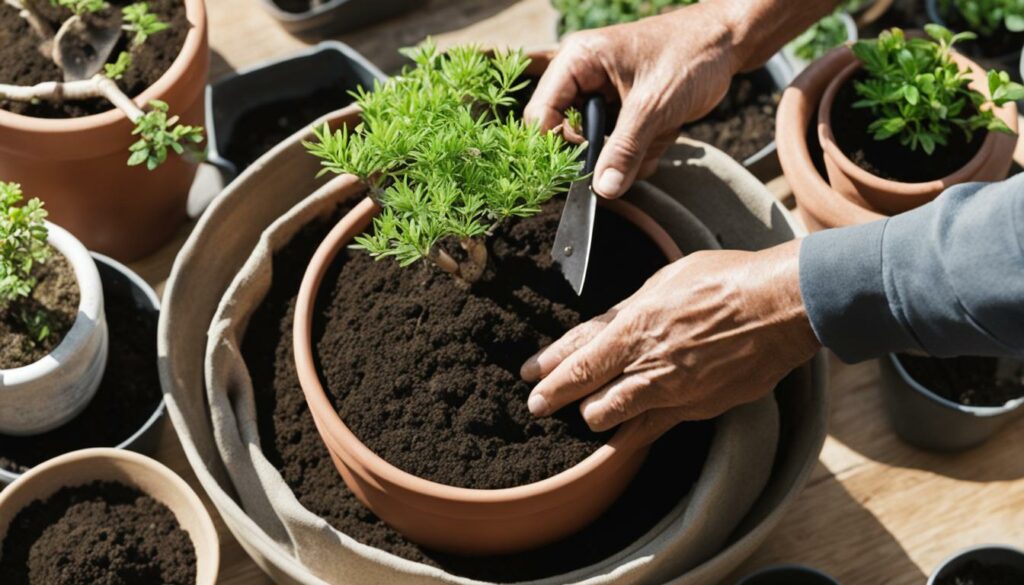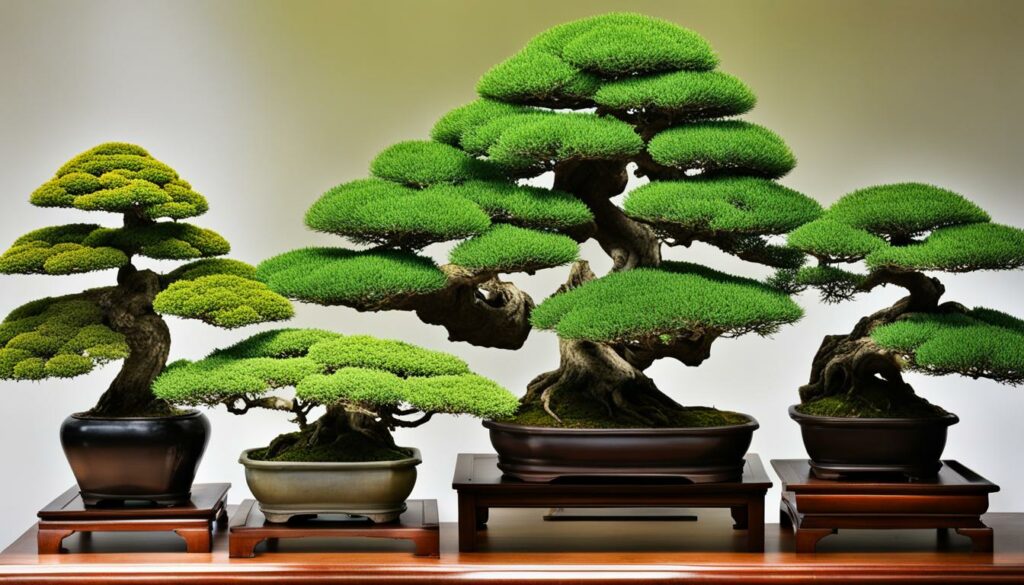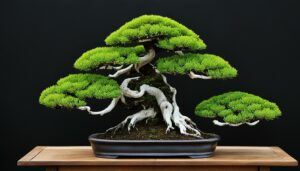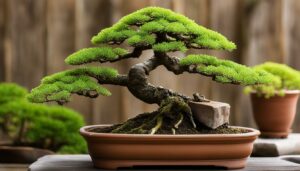Are you fascinated by the art of bonsai cultivation? Do you want to learn how to propagate bonsai trees from cuttings and create your own miniature forest? Look no further, as we have got you covered. In this comprehensive guide, we will walk you through the process of growing bonsai trees from cuttings, covering all the essential techniques and expert tips for successful bonsai propagation. Whether you are a beginner or an experienced enthusiast, this guide will provide you with valuable insights and resources to cultivate and create stunning bonsai trees.
Key Takeaways:
- Propagation is the process of growing plants from cuttings without using seeds, and the same technique can be applied to bonsai cultivation.
- Choosing the right bonsai species to propagate is crucial for success.
- Proper preparation of cutting materials and the growing environment are essential for optimal growth and rooting.
- Rooting hormones can significantly improve success rates when propagating bonsai from cuttings.
- Proper care and maintenance, including pruning, watering, and fertilizing, are crucial for the health and longevity of your bonsai trees.
Understanding Bonsai Cultivation
Before you start growing your own bonsai from cuttings, it’s important to understand the basics of bonsai cultivation. Bonsai is the art of growing miniature trees in a pot or container, and it originated in China more than a thousand years ago. Today, bonsai cultivation has spread around the world, and many people find it to be a rewarding hobby.
There are many different ways to propagate bonsai, including starting from seed, air layering, and grafting. However, growing bonsai from cuttings is a popular method for beginners, and it’s an easy way to get started with bonsai cultivation. With proper care, bonsai starter plants can grow into stunning miniature trees that will be the envy of your friends and family.
One of the keys to successful bonsai cultivation is selecting the right starter plants. Some species of trees are better suited for bonsai cultivation than others, and it’s important to choose the right plants for your needs. Some popular bonsai starter plants include junipers, maples, elms, and ficus trees.
Expert tip:
When choosing bonsai starter plants, look for trees with small leaves, interesting bark, and good branch structure. Avoid trees with thick trunks or excessively long internodes, as these can be difficult to train into the desired shape.
In addition to selecting the right starter plants, it’s important to understand the basics of bonsai care and maintenance. This includes providing the right growing environment, pruning and shaping the tree, and potting and fertilizing as needed. With careful attention to detail, you can create stunning living sculptures that will bring beauty and tranquility to your indoor or outdoor space.
Selecting the Right Bonsai Species
As you venture into bonsai cultivation, selecting the right species is critical. Some bonsai trees are more suitable for propagation from cuttings than others. The following species are recommended for successful cloning of bonsai:
| Bonsai Species | Advantages |
|---|---|
| Juniper | Easy to propagate, drought-resistant, and adaptable to various styles and shapes. |
| Japanese Maple | Enjoys a long lifespan, mid-sized tree, and has attractive fall foliage colors. |
| Bald Cypress | Easily propagated, a great option for outdoor bonsai trees, and become more attractive as they age. |
| Chinese Elm | Resistant to disease and pests, and adaptable to most styles, including informal upright and broom. |
When it comes to selecting the best plants for your bonsai collection, consider the species’ growth habits, hardiness, and adaptability. Select varieties that grow well in your climate, with proper care, and suitable to your aesthetic preferences. Remember, patience and attention to detail are essential in bonsai propagation.
Your tree will begin as a small cutting, but with care and time, it will grow into a magnificent bonsai.”
Preparing the Cutting Materials
Before you begin, it’s important to have your Bonsai cuttings properly collected and prepared to maximize success rates. Here’s how to get started:
- Select a healthy mother plant – choose a healthy, mature plant as the source of your Bonsai cuttings.
- Collect cuttings correctly – take cuttings from the mother plant in the spring or summer, avoiding any brown or damaged stems. Use a clean and sharp pair of scissors to avoid damaging the stems.
- Remove lower leaves and needles – strip off the foliage from the bottom third of the cutting to prevent excess moisture loss and allow light and air circulation from the top.
- Cut at a 45-degree angle – make a clean and sharp angle cut on the stem, just below a leaf node or bud.
- Apply rooting hormone – dip the cut end of the stem in rooting hormone, which stimulates root formation.
- Prepare the potting soil – use a well-draining soil mixture with perlite, sand, and peat moss.
- Pot the cutting – plant the stem cutting in a small pot filled with the prepared soil mixture. Water the soil thoroughly to promote settling of the soil mixture in the container.
Common Mistakes to Avoid
When preparing your Bonsai cuttings, it’s important to avoid common mistakes that can affect their viability:
- Using old or wilted plant material
- Collecting cuttings at the wrong time of year
- Leaving too much foliage on the cutting
- Not applying rooting hormone
- Using poor quality or improperly drained soil
- Overwatering or underwatering the soil
Providing the Ideal Growing Environment
Creating the perfect environment for your bonsai cuttings is crucial to ensure successful growth. To provide optimal conditions, pay attention to the following factors:
| Factor | Optimal Growing Conditions |
|---|---|
| Lighting | Bonsai trees require bright, indirect light to thrive. Place cuttings near a window that receives morning or evening sun, or use a grow light to supplement natural light. |
| Temperature | Bonsai cuttings prefer moderate temperatures between 60-75°F (15-24°C). Protect them from extreme heat or cold, and avoid placing them near heating or cooling vents. |
| Humidity | Bonsai trees benefit from high humidity levels, ideally around 50-70%. Use a humidifier or place a humidity tray filled with water near the cuttings. |
| Soil | Use a well-draining soil mix designed for bonsai cultivation. Avoid over-watering and allow the soil to dry slightly before watering again. |
Remember to monitor these factors regularly and adjust as necessary to provide a stable growing environment for your bonsai cuttings.
Image related to growing environment:
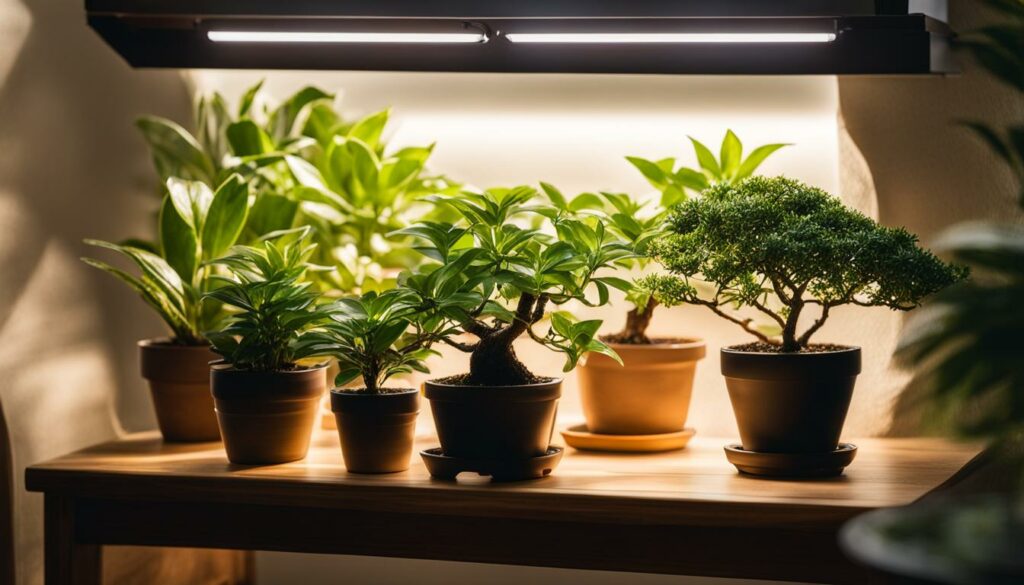
Rooting Hormones and Techniques
Rooting hormones can be a game-changer when it comes to propagating bonsai cuttings. These plant hormones encourage cell division and boost root growth, increasing the chances of successful propagation.
There are different types of rooting hormones available, such as powder, liquid, and gel forms. Each has its own advantages and usage instructions, so make sure to read the label and follow the recommended dosage.
When applying rooting hormones to your bonsai cuttings, make a clean, angled cut at the base of the stem and remove any leaves or buds from the lower section. Dip the cut end into the rooting hormone and tap gently to remove excess powder or gel.
While rooting hormones can increase the success rate, it’s important not to rely solely on them. Proper care and maintenance, including the right growing environment, regular watering, and soil nutrients, are also crucial for the healthy growth of your bonsai cuttings.
Potting and Planting Bonsai Cuttings
Once your bonsai cuttings have developed healthy roots, it’s time to move them into a potting container. This step is vital to ensure the continued growth and development of your bonsai trees.
First, choose a suitable pot with proper drainage holes, ensuring it is not too large or too small for your cuttings. A pot or container made explicitly for bonsai cultivation works best.
Fill the pot with a well-draining soil mix of sandy loam and organic matter, as this helps facilitate healthy root development. Make a hole in the soil for the cutting and gently place it, making sure the roots are spread evenly in the soil.
Lightly tamp down the soil around the cutting to hold it securely in place. Add additional soil as needed, making sure to leave about a half-inch of space between the soil surface and the container’s rim for watering.
Water the soil thoroughly and drain excess water from the pot. Keep the soil moist but not waterlogged, as overwatering can lead to root rot and other issues.
Position the pot in a well-lit area that receives enough sunlight for the chosen bonsai species, avoiding direct, harsh sunlight. Cover your cuttings with a plastic bag or container to maintain humidity for the first few weeks and remove the cover when you observe new growth.
Expert Tip: Consider adding a layer of moss on top of your soil to maintain humidity and provide a natural, aesthetically pleasing look.
Watering and Fertilizing Techniques
Proper watering and fertilizing techniques are critical to the health and vitality of your bonsai trees. Without adequate moisture and nutrients, your plants can suffer from stunted growth, wilting, and leaf drop.
When it comes to watering your bonsai, it’s essential to strike a balance between under and over-watering. Determine your watering frequency based on the climate, humidity, and pot size. An effective technique is to use chopsticks to check the soil’s moisture level, poke them into the soil, and withdraw them once or twice a day to monitor the water content. Utilizing the wrong soil could disrupt watering. In this case, mix 70% Akadama soil, 15% Pumice, and 15% Lava rock.
It’s also important to choose the right fertilizers for your starter plants. The choice of ingredients, concentrations, and ratios can impact growth rates, color, foliation, and flowering. Use organic fertilizers, including kelp meal, bone meal, and fish emulsion, every four weeks. Avoid chemical fertilizers containing high levels of nitrogen, which can burn the root system, leading to browning and dropping leaves.
Note: Avoid overfeeding your bonsai, as it can be harmful. Be mindful of the doses, and act in moderation.
“The best time to fertilize your bonsai is when you begin to see signs of new growth. It’s also important to maintain an appropriate balance between fertilizer and water. Remember to adjust the feeding schedule based on your plant’s individual needs.”
Pruning and Shaping Your Bonsai Trees
Pruning and shaping are crucial techniques for maintaining the health and beauty of your bonsai trees. Properly pruned trees not only create an aesthetic appeal but also improve air circulation, encourage growth, and allow for the development of a denser foliage canopy.
Before pruning, it’s important to identify the branches and leaves that require cutting. Begin by reviewing the guidelines for the particular species of bonsai you are cultivating. This can help you understand the expected growth patterns and how to create a design that aligns with it.
If you want to clone your bonsai with a cutting, you need to prune it by cutting the branches close to the trunk to stimulate growth. This will reduce the overall biomass of the original tree and redirect all its resources to the new cutting. You should also consider the design of your bonsai when pruning. Look for ways to enhance its natural beauty by removing any excess foliage that might be obscuring its true form.
Shaping your bonsai tree is accomplished by wiring. Wiring is a technique used by bonsai enthusiasts to shape and train their trees by placing wires on branches and trunks, bending and twisting them to achieve a desired design. Here is an example of how to wire your bonsai:
Wiring Techniques for Bonsai Trees:
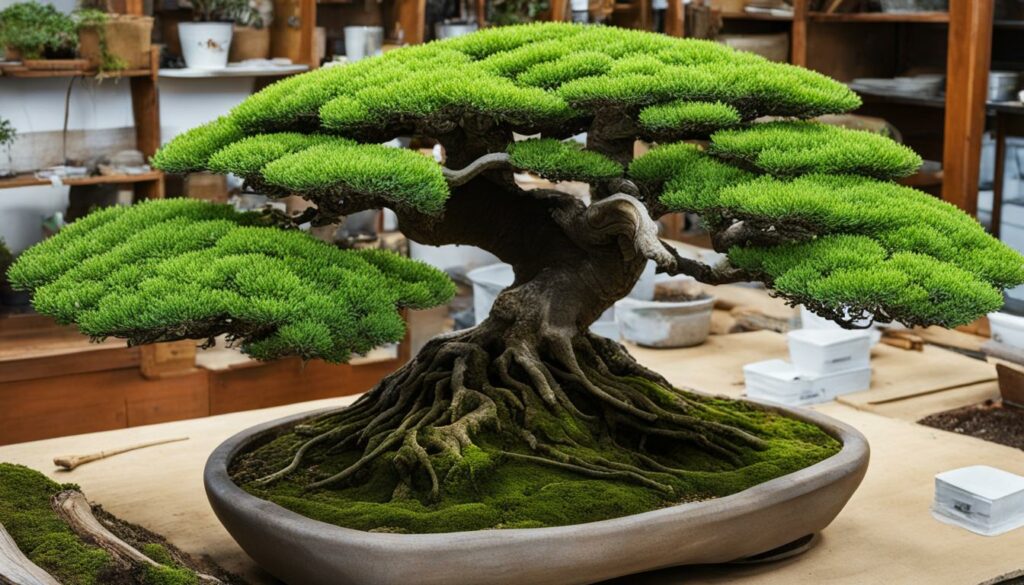
- Choose the right wire size that matches the thickness of the branch you plan to shape.
- Place the wire on the branch, at an angle of 45 degrees, then wrap it around the branch and twist the ends together.
- Gently curve the branch in the direction you want it to go.
- If the wire is cut in, remove it immediately before it scars or scars the branch.
- Check the wire periodically, loosening it or removing it once the branch has set in place.
Once your bonsai tree has been shaped and pruned, it’s important to take care of it and maintain its health with proper watering, fertilizing, and disease control.
Training and Wiring Bonsai Trees
Training and wiring bonsai trees are crucial techniques to mold and sculpt them into your desired forms. Bonsai cultivation allows you to create living sculptures that can express your creativity while fostering serenity and peace in your space. However, improper handling can damage your bonsai, so it’s essential to approach these techniques with care and precision.
Begin by assessing your bonsai’s growth and development. With careful observation, determine the areas that need shaping and trimming to achieve your desired design. Then, you can begin training your bonsai.
Training Bonsai Trees
To train your bonsai tree:
- Pinch off new growth by snipping back buds and tiny branches to maintain your desired shape regularly.
- Gradually bend branches to create the desired angle, avoiding twisting or breaking them. For best results, use your fingers or specialized bonsai pliers to bend branches.
- Use guy wires to anchor branches to stakes or other support to fix them in place while new growth appears.
- Maintain daily care routines, including daily watering, fertilizing, and pruning.
By following these steps, you can mold your bonsai into your desired shape gradually, creating a stunning living sculpture.
Wiring Bonsai Trees
Wiring is the process of wrapping copper or aluminum wire around the trunk and branches of your bonsai tree to guide its growth and create the desired shape. When properly executed, wiring can encourage the growth of branches and maintain the tree’s structure.
However, wiring requires careful handling to avoid damaging your bonsai. Begin by selecting the right gauge and length of wire, so it won’t cut into your bonsai tree’s bark. Then, carefully wrap the wire around the branch or trunk in a helix pattern, ensuring that it remains tight but not too tight. You should remove the wiring as soon as it has done its job, typically after six months to a year.
Remember to use wiring with caution, never leaving it on for too long, as it can cut into your bonsai or damage its growth. When using wiring, monitor your bonsai trees routinely to ensure that it is growing correctly. In summary, with training and wiring, you can create stunning bonsai designs while preserving their health and vigor.
Pest and Disease Control
While bonsai trees are generally hardy, they are still susceptible to pests and diseases. Protecting your trees from these issues is vital for their overall health and longevity.
Common Bonsai Pests
Some common pests that can affect bonsai trees include:
- Aphids
- Spider mites
- Scale insects
- Caterpillars
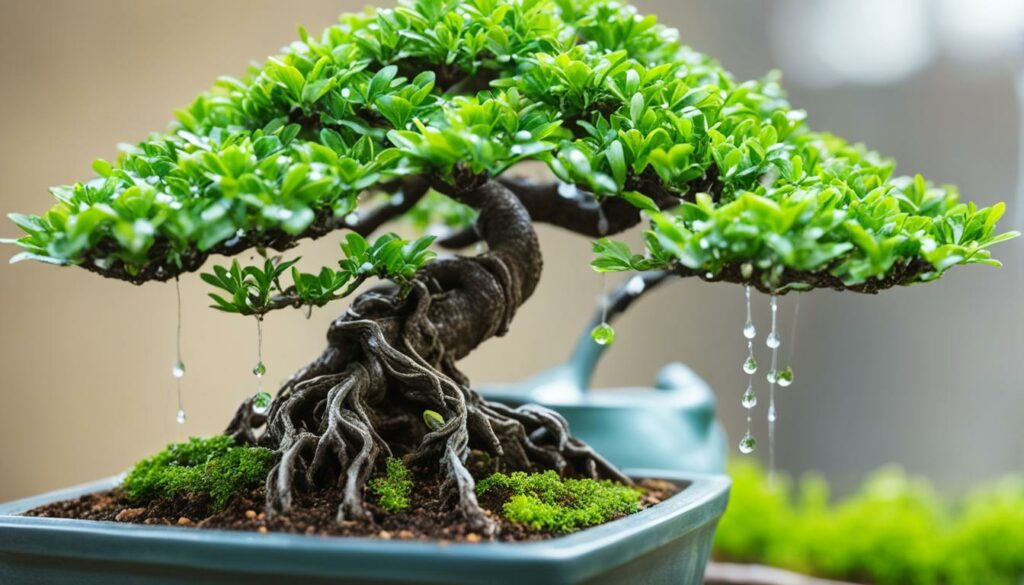
Preventing these pests from infesting your trees is the best approach. Regular inspection and cleaning of your trees, tools, and pots are effective measures. You can also use insecticidal soap or neem oil to repel insects.
Bonsai Diseases
Some common diseases that affect bonsai trees include:
- Root rot
- Powdery mildew
- Leaf spot
- Canker
Fungi and bacteria cause most of these diseases, which can spread rapidly and damage your trees. Monitoring and maintaining an appropriate growing environment, including good ventilation and water drainage, are crucial preventive steps. Quarantine infected trees from other bonsai, prune dead branches, and use fungicides or bactericides when necessary.
Effective Methods for Prevention and Control
To avoid pest and disease problems, prevention is key. Here are some effective methods for prevention and control:
- Clean tools and pots before use
- Use sterilized soil mixtures
- Provide optimal growing conditions, including light, temperature, and humidity levels
- Remove dead or diseased leaves, branches, and debris promptly
- Monitor your trees regularly for pests and diseases, and take immediate action when detected
Following these best practices can help keep your bonsai trees healthy and reduce the risk of pest and disease problems.
Bonsai Care and Maintenance
Proper care and maintenance are the keys to keeping your bonsai trees thriving. To ensure that your bonsai remains healthy and vibrant, you need to focus on essential aspects such as:
- Pruning: Regular pruning is necessary to ensure that your bonsai maintains its desired shape and size. Trim back any overgrown or dead branches to promote new growth and improve the overall look of your tree.
- Watering: Adequate watering is crucial for the health of your bonsai. Be sure to water your bonsai when the soil starts to feel slightly dry and avoid over-watering, which can lead to root rot.
- Repotting: Bonsai trees should be repotted every 1-2 years to prevent root-bound, which can stunt their growth. When repotting, be sure to prune any damaged or diseased roots before re-potting in fresh soil.
- Seasonal Considerations: Different seasons require different care for your bonsai. During winter, it is essential to protect your bonsai from extreme cold, while providing sufficient warmth and light during summer.
Remember that bonsai trees are living creatures that require careful attention and maintenance to thrive. By keeping up with these essential care and maintenance tasks, you can ensure that your bonsai tree brings you joy and beauty for many years to come.
Displaying and Showcasing Your Bonsai
Once you’ve successfully grown your bonsai, you’ll want to showcase your masterpiece. There are many ways to present your bonsai, be it indoors or outdoors.
Indoor Display
Indoor locations offer an ideal environment for creating a serene ambiance with your bonsai. With proper placement, your bonsai can become an eye-catching centerpiece in your home or office. Place your bonsai near a natural light source, such as a window, to ensure adequate sunlight. Avoid placing your bonsai in drafty areas or near heating or cooling vents. Bonsai thrive in stable temperatures and require a humid environment, so a humidifier may be necessary to maintain optimal moisture levels.
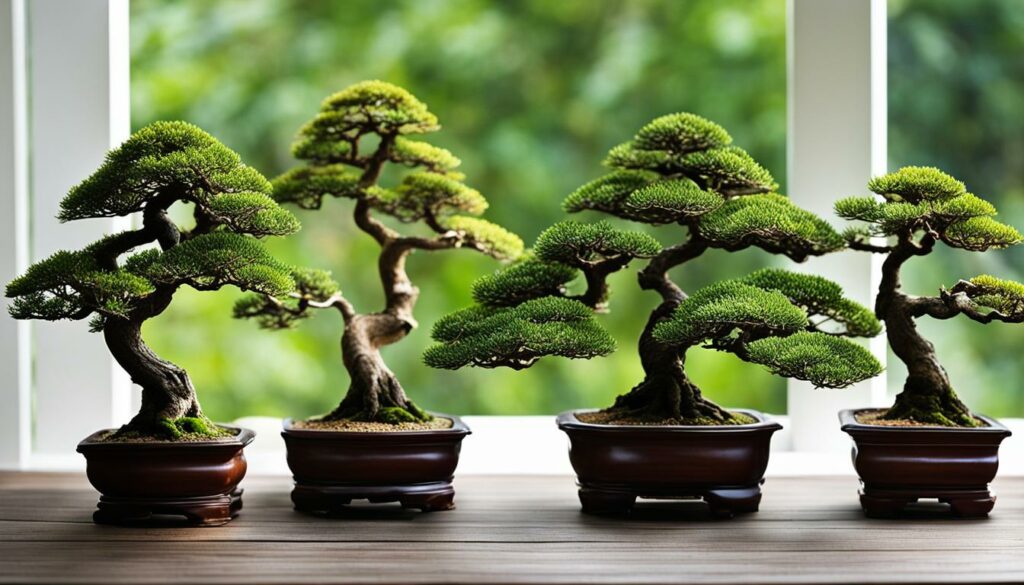
Outdoor Display
Outdoor displays provide a natural backdrop for your bonsai and allow it to thrive in its natural environment. Place your bonsai on a sturdy stand or pedestal to draw attention to its artistic qualities. Consider grouping your bonsai with other trees or plants to create a harmonious landscape. Be mindful of the weather conditions, as extreme temperatures or strong winds can damage your bonsai. It is also important to keep an eye out for pests and diseases that can harm your beloved trees.
Exhibitions and Competitions
If you’re looking to showcase your bonsai to a wider audience, consider entering exhibitions or competitions. These events offer an opportunity to network with other bonsai enthusiasts and showcase your skills. Take extra care to prepare your bonsai for the competition/stage, ensuring it is meticulously groomed and perfectly pruned.
Bonsai Stands
Bonsai display stands are essential in presenting your bonsai trees at their best. With a variety of shapes and sizes, these stands add an artistic touch to your bonsai presentation. Whether displaying indoors or outdoors, a stand will elevate your bonsai and present it as the true work of art it is.
Keep in mind that the presentation should emphasize the beauty of your tree, while remaining unobtrusive and complementary to the bonsai’s natural aesthetic.
Bonsai Cultivation Tips and Tricks
Now that you have the basics of bonsai cultivation from cuttings down, it’s time to refine your techniques. Here are some tips and tricks from experienced bonsai enthusiasts to take your cultivation to the next level:
Experiment with Styling
Don’t be afraid to experiment with different bonsai styles to find your personal aesthetic. Try shaping your bonsai into dynamic compositions such as cascade, semi-cascade, or windswept styles, or opt for more traditional designs like formal or informal upright.
Explore Advanced Propagation Techniques
If you want to take your bonsai cultivation skills to the next level, consider exploring advanced propagation methods such as air layering or grafting. These methods allow you to create multiple bonsai trees from a single parent plant, allowing for greater customization and variety in your collection.
Invest in Quality Tools
The right tools can make all the difference when it comes to bonsai cultivation. Invest in quality pruning shears, wire cutters, and other key gardening tools to ensure precision and accuracy in your styling and upkeep.
Consider Outdoor Placement
Bonsai trees can thrive both indoors and outdoors, but outdoor placement can result in larger, healthier trees. Consider placing your bonsai outside during warm weather to take advantage of natural sunlight and rainfall.
Join a Bonsai Community
Joining a local bonsai community or club can provide you with valuable resources and support when it comes to your cultivation journey. You can learn from experienced enthusiasts, receive feedback on your techniques, and even participate in exhibitions and competitions to showcase your skills.
By incorporating these tips and tricks, you can refine your bonsai cultivation skills and create truly stunning living sculptures.
Troubleshooting Common Issues
Despite your best efforts, sometimes bonsai trees encounter issues that can be detrimental to their growth and development. Here are some common problems you may encounter when cultivating bonsai trees from starter plants:
Yellowing Leaves
If your bonsai’s leaves start to yellow, it could be due to a lack of nutrients, overwatering, or poor lighting conditions. To remedy the issue, adjust your watering schedule, provide additional nutrients, and ensure your bonsai is receiving adequate light.
Root Rot
Root rot can occur when the soil is too moist and lacks proper drainage. If you suspect root rot, carefully remove the bonsai from its pot and examine the roots. If they appear brown and mushy, trim away the affected roots and repot in fresh soil with improved drainage.
Wilting
Wilting can happen due to underwatering or overwatering, as well as poor growing conditions. Check the soil moisture levels and adjust your watering accordingly. Ensure your bonsai is placed in an area with proper lighting and suitable temperature and humidity levels.
By troubleshooting common issues like these, you can save your bonsai from potential setbacks and keep them thriving. Remember to closely monitor your bonsai’s growth and make adjustments as necessary to create the ideal growing environment.
Conclusion: Start Your Bonsai Cultivation from Cuttings Today
Now that you have completed our step-by-step guide to bonsai cultivation from cuttings, you are ready to embark on your own bonsai journey. Growing bonsai from cuttings is a rewarding and fulfilling experience that will bring beauty and tranquility to your space.
Remember to select the right bonsai species and take great care in preparing the cutting materials. Providing the ideal growing environment with the appropriate lighting, temperature, and humidity is essential for the healthy growth of your bonsai trees. Utilizing rooting hormones and proper watering techniques will further enhance the success of your bonsai propagation.
Once your bonsai cuttings have developed roots, it’s time to transition them to pots with the right soil and fertilizers. Pruning, shaping, and training your bonsai trees is an art that requires patience and skill, but the results are truly stunning. Protecting your bonsai from pests and diseases with effective prevention and control methods is vital for their overall health and longevity.
Displaying your bonsai trees is an art in itself, with indoor and outdoor options, stands, and exhibitions or competitions to consider. Remember to always care for and maintain your bonsai trees with regular pruning, watering, and seasonal considerations.
By following these expert techniques and tips, you can successfully cultivate your own miniature trees and enjoy the art of bonsai. Start your bonsai cultivation from cuttings journey today and create stunning living sculptures that will bring beauty and tranquility to your life.
FAQ
Can bonsai trees be grown from cuttings?
Yes, bonsai trees can be propagated from cuttings. This method involves taking a small section of a parent tree and encouraging it to develop roots and grow into a new bonsai tree.
What is propagation?
Propagation is the process of reproducing plants by taking cuttings, seeds, or other plant parts and creating new individual plants from them.
How do I clone a bonsai tree?
Cloning a bonsai tree involves taking a cutting from the parent tree and following specific steps to encourage root growth and new foliage. This process allows you to create an exact replica of the original tree.
What are starter plants?
Starter plants are young plants that are ready to be developed into bonsai trees. These are typically obtained through propagation methods such as cuttings or seeds.
